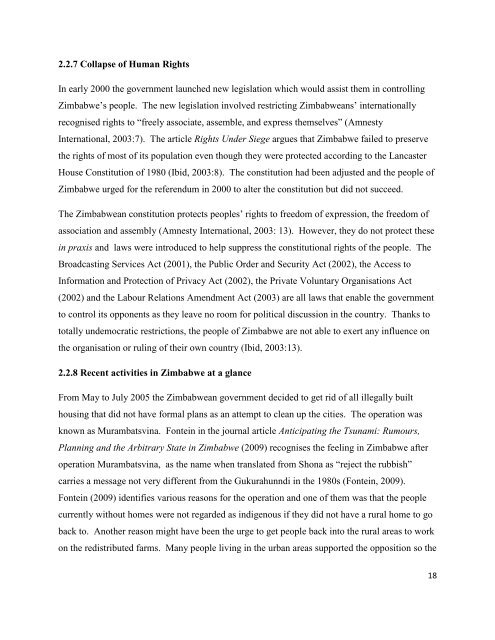Guro Lauvland Bjorknes.pdf - NMMU
Guro Lauvland Bjorknes.pdf - NMMU
Guro Lauvland Bjorknes.pdf - NMMU
You also want an ePaper? Increase the reach of your titles
YUMPU automatically turns print PDFs into web optimized ePapers that Google loves.
2.2.7 Collapse of Human Rights<br />
In early 2000 the government launched new legislation which would assist them in controlling<br />
Zimbabwe‟s people. The new legislation involved restricting Zimbabweans‟ internationally<br />
recognised rights to “freely associate, assemble, and express themselves” (Amnesty<br />
International, 2003:7). The article Rights Under Siege argues that Zimbabwe failed to preserve<br />
the rights of most of its population even though they were protected according to the Lancaster<br />
House Constitution of 1980 (Ibid, 2003:8). The constitution had been adjusted and the people of<br />
Zimbabwe urged for the referendum in 2000 to alter the constitution but did not succeed.<br />
The Zimbabwean constitution protects peoples‟ rights to freedom of expression, the freedom of<br />
association and assembly (Amnesty International, 2003: 13). However, they do not protect these<br />
in praxis and laws were introduced to help suppress the constitutional rights of the people. The<br />
Broadcasting Services Act (2001), the Public Order and Security Act (2002), the Access to<br />
Information and Protection of Privacy Act (2002), the Private Voluntary Organisations Act<br />
(2002) and the Labour Relations Amendment Act (2003) are all laws that enable the government<br />
to control its opponents as they leave no room for political discussion in the country. Thanks to<br />
totally undemocratic restrictions, the people of Zimbabwe are not able to exert any influence on<br />
the organisation or ruling of their own country (Ibid, 2003:13).<br />
2.2.8 Recent activities in Zimbabwe at a glance<br />
From May to July 2005 the Zimbabwean government decided to get rid of all illegally built<br />
housing that did not have formal plans as an attempt to clean up the cities. The operation was<br />
known as Murambatsvina. Fontein in the journal article Anticipating the Tsunami: Rumours,<br />
Planning and the Arbitrary State in Zimbabwe (2009) recognises the feeling in Zimbabwe after<br />
operation Murambatsvina, as the name when translated from Shona as “reject the rubbish”<br />
carries a message not very different from the Gukurahunndi in the 1980s (Fontein, 2009).<br />
Fontein (2009) identifies various reasons for the operation and one of them was that the people<br />
currently without homes were not regarded as indigenous if they did not have a rural home to go<br />
back to. Another reason might have been the urge to get people back into the rural areas to work<br />
on the redistributed farms. Many people living in the urban areas supported the opposition so the<br />
18
















